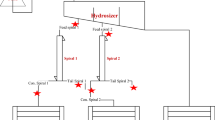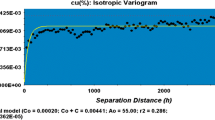Abstract
Experiments were carried out using a spiral concentrator test rig containing feed conditioner, centrifugal pump and a spiral concentrator with feed to spiral and recirculation. Time samples of concentrate and tails were collected, weighed, dried analysed. Regression equations were developed for Concentrate yield, grade and percent recovery of iron values using Box Behnken Model and Minitab 19 software. The optimised yield, grade and percent recovery are 69.98, 64.98 and 79.20 against the target values of 70.00, 65.00 and 80.00 respectively at 16.00% solids, 2.20 m3/h feed rate and 14.40 cm splitter position. Surface (wire mesh) plots were drawn using Minitab 19 to explain the relation between independent variables and response variables. Maximum yield predicted was 80.24% by weight at a feed consistency of 20.00% solids, feed rate of 1 m3/h and at a splitter position of 16.00 cm whereas the minimum yield predicted was 17.19% by weight at a feed consistency of 30.00% solids, feed rate of 3 m3/h and splitter position of 12.00 cm. Maximum grade predicted was 68.73%Fe at a feed consistency of 30% solids, feed rate of 1.00 m3/h and splitter position of 12.00 cm, whereas the minimum grade predicted was 61.03%Fe at a feed consistency of 10% solids, feed rate of 1 m3/h and splitter position of 16.00 cm. The maximum percent of iron values recovery predicted was 86.19 at a feed consistency of 20.00% solids, feed rate of 1.0 m3/h and splitter position of 16.00 cm whereas the minimum recovery predicted was 18.82% at a feed consistency of 30% solids, feed rate of 3 m3/h and splitter position of 12.00 cm. Surface plots were used to explain the variation in response variables concentrate yield, grade and recovery of iron values.










Similar content being viewed by others
References
Aslan N (2008) Application of response surface methodology and central composite rotatable design for modeling and optimization of a multi-gravity separator for chromite concentration. Powder Technol 185:80–86
Atasoy Y, Spottiswood DJ (1995) A study of particle separation in a spiral concentrator. Min Eng 8(1995):1197–1208
Das B, Prakash S, Mohapatra BK, Bhaumik SK, Narasimhan KS (1992) Beneficiation of iron ore slimes using hydrocyclone. Min Metall Process 9(2):101–103
Dehaine Q, Filippov LO (2016) Modelling heavy and gangue mineral size recovery curves using the spiral concentration of heavy minerals from kaolin residues. Powder Technol 292:331–341
Dixit P, Tiwari R, Mukherjee AK, Banerjee PK (2015) Application of response surface methodology for modeling and optimization of spiral separator for processing of iron ore slime. Powder Technol 275:105–112. https://doi.org/10.1016/j.powtec.2015.01.068
Gulsoy OY, Kademli M (2006) Effect of operational parameters of spiral concentrator on mica-feldspar separation. Min Process Extract Metall 115:80–84
Holland Batt AB, Holtham PN (1991) Particle and fluid motion on Spiral separators. Min Eng 4:457–482
Holland-Batt (1989), Spiral separation: theory and simulation, Trans. Instn. Min. Metall. (Sect. C) 98 (1989) C46 to C60
Honaker RQ, Jain M, Parekh BK, Saracoglu M (2007) Ultrafine coal cleaning using spiral concentrators. Min Eng 20(2007):1315–1319
Indian Bureau of Mines, Indian Minerals Yearbook 2018 (Part- III: Mineral Reviews) 57th Edition Iron Ore, Government of India, Ministry of Mines, Indian Bureau of Mines, Nagpur
Jain V, Tammishetti V, Joshi K, Kumar D, Rai B (2017) Guar gum as a selective flocculant for the beneficiation of alumina-rich iron ore slimes: density functional theory and experimental studies. Miner Eng 109:144–152
Kapur PC, Meloy TP (1999) Industrial modeling of Spiral for optimal configuration and design: spiral geometry, fluid flow and forces on particles. Powder Technol 102(1999):244–252
Kumar R, Mandre NR (2017) Recovery of iron from iron ore slimes by selective flocculation. J South Afr Inst Min Metall 117:397–400
Mishra BK, Tripathy A (2010) A preliminary study of particle separation in spiral concentrators using DEM. Int J Min Process 94(2010):192–195
Mukherjee AK, Thella JS, Makhija D, Patra AS, Manna M, Ghosh TK (2014) Process to recover iron values from high-alumina indian iron ore slime—a bench-scale study. Min Process Extract Metall Rev 36(1):39–44. https://doi.org/10.1080/08827508.2013.867854
Pan SK, Chowdhury GM, Sinha V, Saha SK and Rai S (2012) Recovery of valuable iron ore concentrate particles from the process rejects of the iron ore processing plant of Dalli mines of SAIL, India, Proceedings of XXVI, IMPC 2012, New Delhi, p 4075
Pattanaik A, Rayasam V (2018) Analysis of reverse cationic iron ore fines flotation using RSM-D-optimal design–an approach towards sustainability. Adv Powder Technol. https://doi.org/10.1016/j.apt.2018.09.021
Prakash S, Das B, Mohapatra BK, Venugopal R (2000) Recovery of iron values from iron ore slimes by selective magnetic coating. Separat Sci Technol 35(16):2651–2662
Rao GV, Markandeya R, Sharma SK (2016) Recovery of iron values from iron ore slimes of donimalai tailing dam. Trans Indian Inst Met 69:143–150. https://doi.org/10.1007/s12666-015-0809-0
Rao GV, Markandeya R, Kumar R (2018) Feasibility studies for production of pellet grade concentrate from sub grade iron ore using multi gravity separator. J Inst Eng India Ser D 99:63–70. https://doi.org/10.1007/s40033-017-0147-y
Richards RG, Mac Hunter DM, Gates PJ, Palmer MK (2000) Gravity separation of ultra-fine (–0.1 mm) minerals using spiral separators. Min Eng 13(1):65–77
Rocha L, Cancado RZL, Peres AEC (2010) Iron ore slimes flotation. Min Eng 23(11–13):842–845
Roy S, Das A (2008) Characterization and processing of low-grade iron ore slime from the Jilling area of India. Min Process Extract Metall Rev 29(3):213–231
Sadeghi M, Bazin C, Renaud M (2014) Effect of wash water on the mineral size recovery curves in a spiral concentrator used for iron ore processing. Int J Miner Process 129:22–26
Santanu Sarkar and Supriya Sarkar (2018) Beneficiation of rejects slime of iron ore by means of sequential leaching. Metall Res Technol 116:202. https://doi.org/10.1051/metal/2018074
Singh S, Sahoo H, Rath SS, Sahu AK, Das B (2015) Recovery of iron minerals from Indian iron ore slimes using a colloidal magnetic coating. Powder Technol 269:38–45
Sivamohan R, Forssberg E (1985) Principles of spiral concentration’. Int J Min Process 15:173–181
Stokes YM (2001) Computing flow in a Spiral particle separator, 14th Australian fluid mechanics conference, Adelide University, Adelide, Australia 10–14 December 2001
Sunil SR, Rayapudi V, Dhawan N (2020) Recovery of iron values from discarded iron ore slimes. Min Metall Explor 37:287–295. https://doi.org/10.1007/s42461-019-00119-2
Tripathy SK, Rama Murthy Y (2012) Modelling and Optimisation of spiral concentrator for separation of ultrafine chromite. Powder Technol 221:387–394
Vasumathi N, Vijaya Kumar TV, Subba Rao S, Prabhakar S and Bhaskar Raju G (2012) Recovery of values from tailing ponds of iron ore washing plants, Proceedings of XXVI, IMPC 2012, New Delhi, p 5703
Vermaak MKG, Visser HJ, Bosman JB, Krebs G (2008) A simple process control model for spiral concentrators. J South Afr Inst Min Metall 108(3):147–154
Vijaya Kumar TV, Rao DS, Subba Rao S, More P, Reddy YS, Prabhakar S, Bhaskar Raju G (2005) Beneficiation of iron ore fines by conventional flotation, flotation column and dual extraction column—a pilot scale study. Powder Handl Process 17(2):88–93
Vijaya Kumar TV, Rao DS, Subba Rao S, Prabhakar S, Bhaskar Raju G (2010) Reverse flotation studies on an Indian low grade iron ore slimes. Int J Eng Sci Technol 2(4):634–645
Acknowledgements
The authors sincerely thank the management of NMDC Limited for approving to conduct beneficiation studies and permitting to publish this paper. The authors also wish to acknowledge the lively discussions and suggestions by their colleagues at R&D Centre, NMDC Limited.
Author information
Authors and Affiliations
Corresponding author
Additional information
Publisher's Note
Springer Nature remains neutral with regard to jurisdictional claims in published maps and institutional affiliations.
Rights and permissions
About this article
Cite this article
Rao, G.V., Rath, B., Sharma, P. et al. Modeling and Optimisation of Spiral Concentrator for Beneficiation of Iron Ore Slimes from Kirandul, India. Trans Indian Natl. Acad. Eng. 5, 497–508 (2020). https://doi.org/10.1007/s41403-020-00155-1
Received:
Revised:
Accepted:
Published:
Issue Date:
DOI: https://doi.org/10.1007/s41403-020-00155-1




